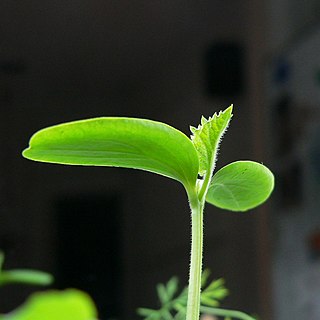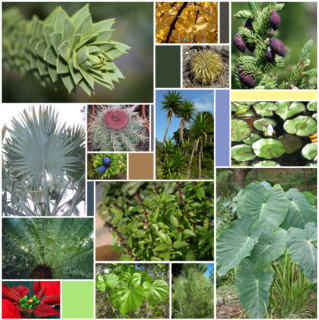Related Research Articles

In botany, a bud is an undeveloped or embryonic shoot and normally occurs in the axil of a leaf or at the tip of a stem. Once formed, a bud may remain for some time in a dormant condition, or it may form a shoot immediately. Buds may be specialized to develop flowers or short shoots, or may have the potential for general shoot development. The term bud is also used in zoology, where it refers to an outgrowth from the body which can develop into a new individual.

In botany, shoots consist of stems including their appendages, the leaves and lateral buds, flowering stems and flower buds. The new growth from seed germination that grows upward is a shoot where leaves will develop. In the spring, perennial plant shoots are the new growth that grows from the ground in herbaceous plants or the new stem or flower growth that grows on woody plants.

In botany, phyllotaxis or phyllotaxy is the arrangement of leaves on a plant stem. Phyllotactic spirals form a distinctive class of patterns in nature.
Heliotropism, a form of tropism, is the diurnal or seasonal motion of plant parts in response to the direction of the Sun.
Theoretical production ecology tries to quantitatively study the growth of crops. The plant is treated as a kind of biological factory, which processes light, carbon dioxide, water, and nutrients into harvestable parts. Main parameters kept into consideration are temperature, sunlight, standing crop biomass, plant production distribution, nutrient and water supply.
Leaf area index (LAI) is a dimensionless quantity that characterizes plant canopies. It is defined as the one-sided green leaf area per unit ground surface area in broadleaf canopies. In conifers, three definitions for LAI have been used:

The normalized difference vegetation index (NDVI) is a simple graphical indicator that can be used to analyze remote sensing measurements, often from a space platform, assessing whether or not the target being observed contains live green vegetation.

Diplocarpon earlianum is a species of fungus that causes disease in strawberry plants called strawberry leaf scorch. The disease overwinters in plant debris and infects strawberry plants during the spring season when it is wet. The five main methods to reduce strawberry leaf scorch include: irrigation techniques, crop rotation, planting resistant and disease-free seeds, fungicide use, and sanitation measures. Control of strawberry leaf scorch is important because it is responsible for the majority of disease in strawberries. Diplocarpon earliana affects the fruit quality and yield of the strawberry crop. Losses range from negligible to severe depending on numerous epidemiological factors including cultivar susceptibility, type of cropping system, and weather conditions

Hemispherical photography, also known as canopy photography, is a technique to estimate solar radiation and characterize plant canopy geometry using photographs taken looking upward through an extreme wide-angle lens or a fisheye lens. Typically, the viewing angle approaches or equals 180-degrees, such that all sky directions are simultaneously visible. The resulting photographs record the geometry of visible sky, or conversely the geometry of sky obstruction by plant canopies or other near-ground features. This geometry can be measured precisely and used to calculate solar radiation transmitted through plant canopies, as well as to estimate aspects of canopy structure such as leaf area index. Detailed treatments of field and analytical methodology have been provided by Paul Rich and Robert Pearcy (1989).
This page provides a glossary of plant morphology. Botanists and other biologists who study plant morphology use a number of different terms to classify and identify plant organs and parts that can be observed using no more than a handheld magnifying lens. This page provides help in understanding the numerous other pages describing plants by their various taxa. The accompanying page—Plant morphology—provides an overview of the science of the external form of plants. There is also an alphabetical list: Glossary of botanical terms. In contrast, this page deals with botanical terms in a systematic manner, with some illustrations, and organized by plant anatomy and function in plant physiology.
Important structures in plant development are buds, shoots, roots, leaves, and flowers; plants produce these tissues and structures throughout their life from meristems located at the tips of organs, or between mature tissues. Thus, a living plant always has embryonic tissues. By contrast, an animal embryo will very early produce all of the body parts that it will ever have in its life. When the animal is born, it has all its body parts and from that point will only grow larger and more mature. However, both plants and animals pass through a phylotypic stage that evolved independently and that causes a developmental constraint limiting morphological diversification.

A leaf is the principal lateral appendage of the vascular plant stem, usually borne above ground and specialized for photosynthesis. The leaves, stem, flower and fruit together form the shoot system. Leaves are collectively referred to as foliage, as in "autumn foliage". In most leaves, the primary photosynthetic tissue, the palisade mesophyll, is located on the upper side of the blade or lamina of the leaf but in some species, including the mature foliage of Eucalyptus, palisade mesophyll is present on both sides and the leaves are said to be isobilateral. Most leaves are flattened and have distinct upper (adaxial) and lower (abaxial) surfaces that differ in color, hairiness, the number of stomata, the amount and structure of epicuticular wax and other features. Leaves are mostly green in color due to the presence of a compound called chlorophyll that is essential for photosynthesis as it absorbs light energy from the sun. A leaf with lighter-colored or white patches or edges is called a variegated leaf.

In viticulture, the canopy of a grapevine includes the parts of the vine visible aboveground - the trunk, cordon, stems, leaves, flowers, and fruit. The canopy plays a key role in light energy capture via photosynthesis, water use as regulated by transpiration, and microclimate of ripening grapes. Canopy management is an important aspect of viticulture due to its effect on grape yields, quality, vigor, and the prevention of grape diseases. Various viticulture problems, such as uneven grape ripening, sunburn, and frost damage, can be addressed by skillful canopy management. In addition to pruning and leaf trim, the canopy is often trained on trellis systems to guide its growth and assist in access for ongoing management and harvest.
Plant stress measurement is the quantification of environmental effects on plant health. When plants are subjected to less than ideal growing conditions, they are considered to be under stress. Stress factors can affect growth, survival and crop yields. Plant stress research looks at the response of plants to limitations and excesses of the main abiotic factors, and of other stress factors that are important in particular situations. Plant stress measurement usually focuses on taking measurements from living plants. It can involve visual assessments of plant vitality, however, more recently the focus has moved to the use of instruments and protocols that reveal the response of particular processes within the plant
Biomass partitioning is the process by which plants divide their energy among their leaves, stems, roots, and reproductive parts. These four main components of the plant have important morphological roles: leaves take in CO2 and energy from the sun to create carbon compounds, stems grow above competitors to reach sunlight, roots absorb water and mineral nutrients from the soil while anchoring the plant, and reproductive parts facilitate the continuation of species. Plants partition biomass in response to limits or excesses in resources like sunlight, carbon dioxide, mineral nutrients, and water and growth is regulated by a constant balance between the partitioning of biomass between plant parts. An equilibrium between root and shoot growth occurs because roots need carbon compounds from photosynthesis in the shoot and shoots need nitrogen absorbed from the soil by roots. Allocation of biomass is put towards the limit to growth; a limit below ground will focus biomass to the roots and a limit above ground will favor more growth in the shoot.
Leaf plastocron index is a measure of plant leaf age based on morphological development. It is useful in studying plant development requiring destructive measurement on multiple individuals. By measuring a metric against morphological age, instead of chronological time, one can reduce variations occurring between individuals, thus allowing greater focus on variations due to development.
In mathematics, the three-gap theorem, three-distance theorem, or Steinhaus conjecture states that if one places n points on a circle, at angles of θ, 2θ, 3θ ... from the starting point, then there will be at most three distinct distances between pairs of points in adjacent positions around the circle. When there are three distances, the largest of the three always equals the sum of the other two. Unless θ is a rational multiple of π, there will also be at least two distinct distances.
Biomass allocation is a concept in plant biology which indicates the relative proportion of plant biomass present in the different organs of a plant. It can also be used for whole plant communities.
Plant growth analysis refers to a set of concepts and equations by which changes in size of plants over time can be summarised and dissected in component variables. It is often applied in the analysis of growth of individual plants, but can also be used in a situation where crop growth is followed over time.
Plant density is the number of individual plants present per unit of ground area. It is most easily interpreted in the case of monospecific stands, where all plants belong to the same species and have germinated at the same time. However, it could also indicate the number of individual plants found at a given location.
References
- ↑ Silk, Wendy Kuhn; Erickson, Ralph O. (1979). "Kinematics of plant growth". Journal of Theoretical Biology. 76 (4): 481–501. doi:10.1016/0022-5193(79)90014-6.
- ↑ FJ Richards, Philos. Trans. R. Soc. London, Ser. B 235, 509 (1951).
- ↑ Orthostichy, Parastichy and Plastochrone Ratio in a Central Theory of Phyllotaxis